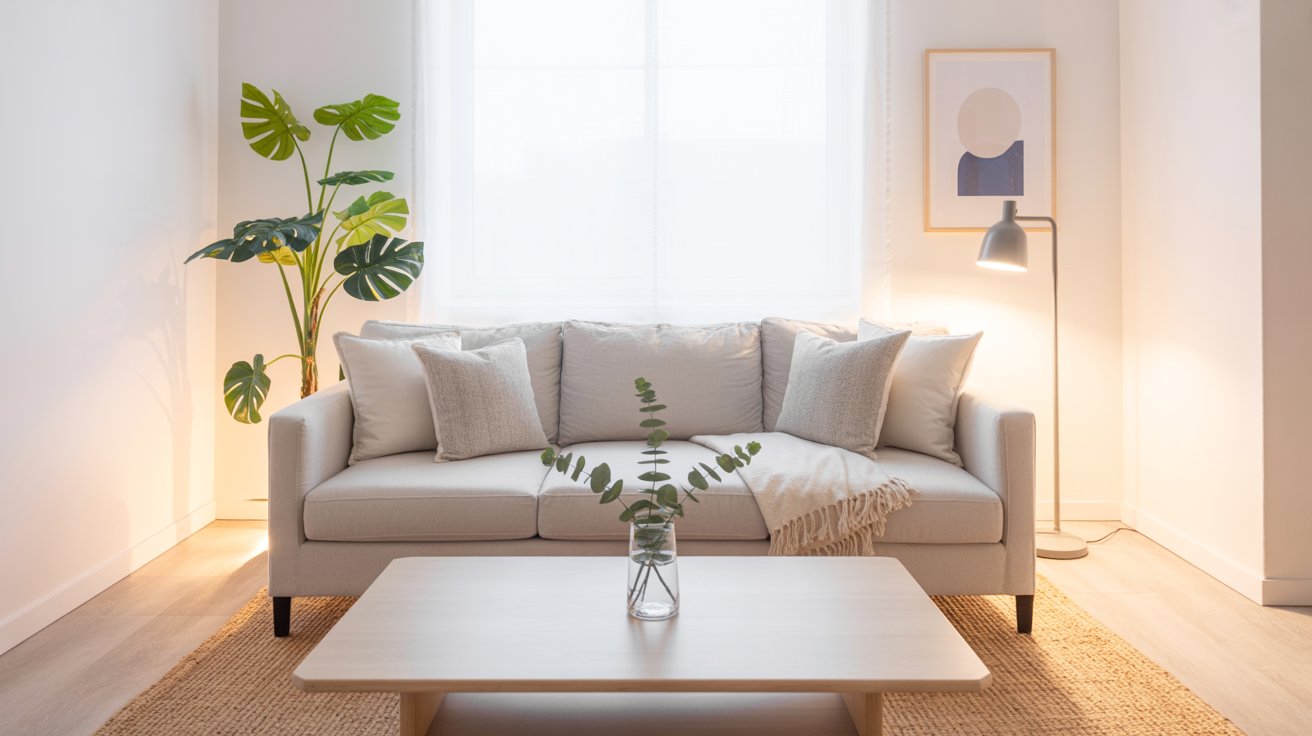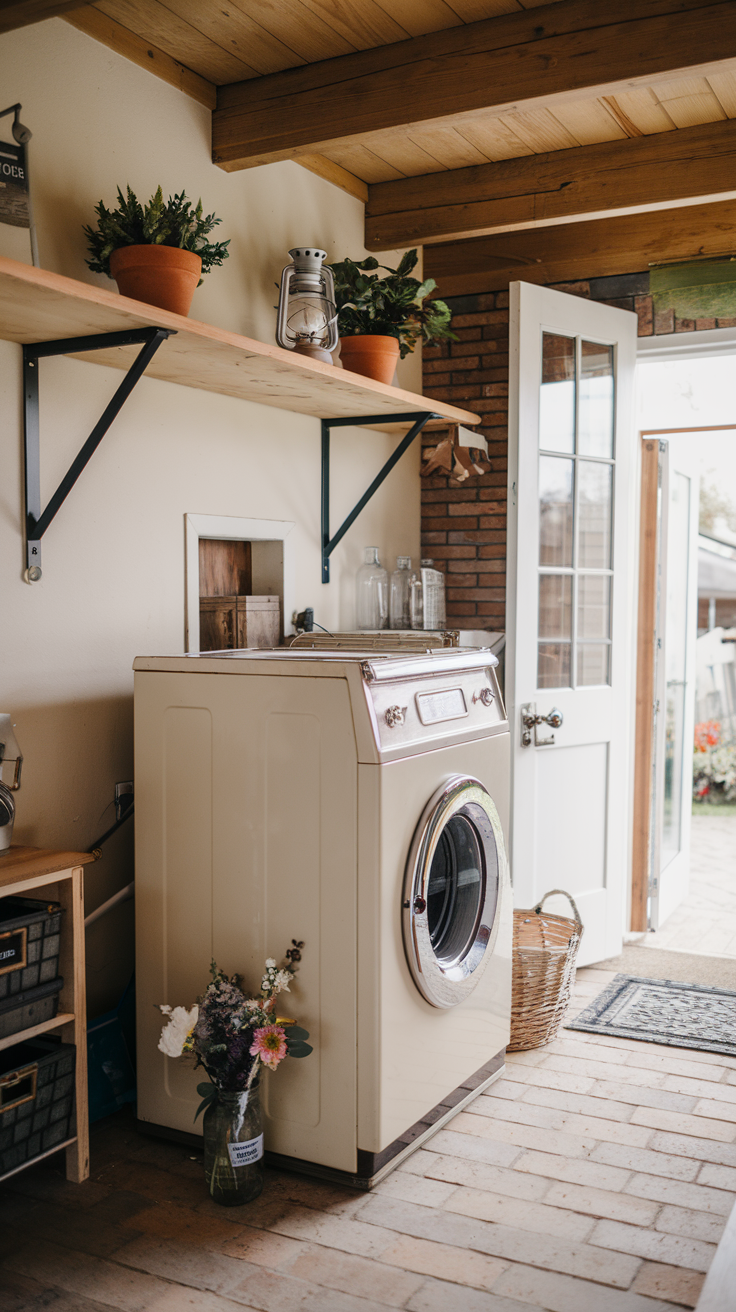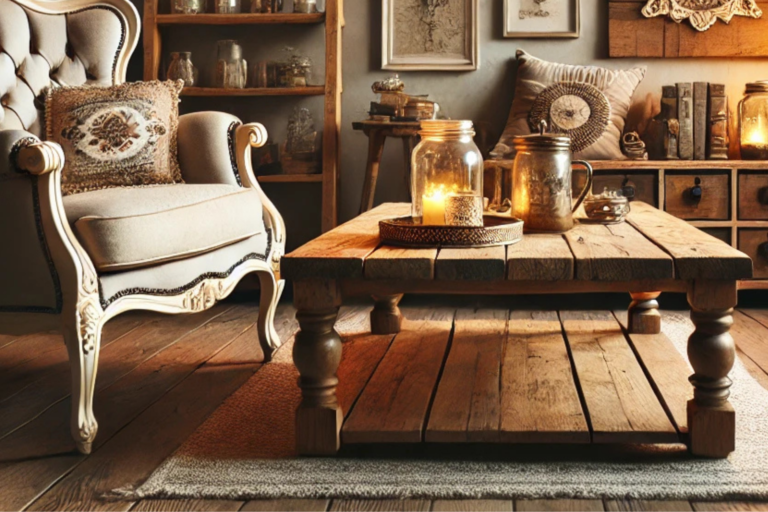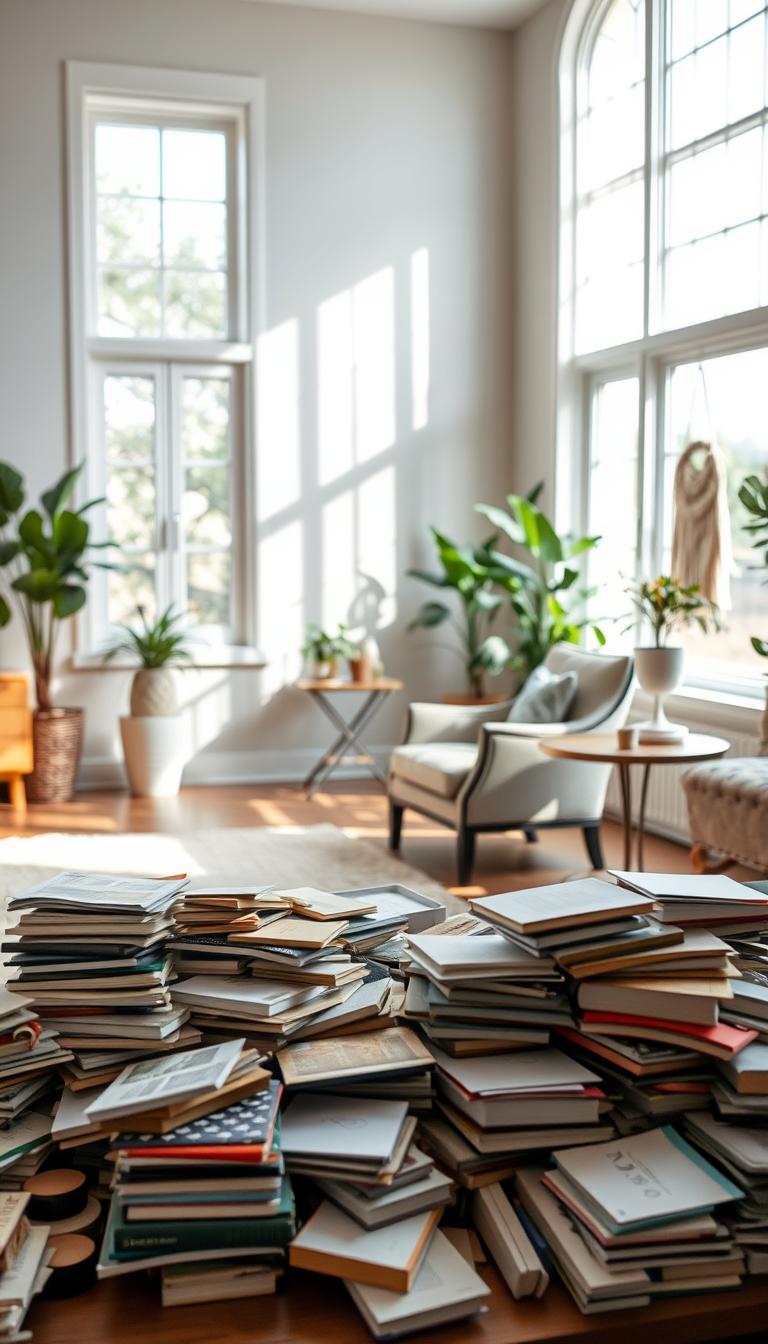Did you know over 60% of urban UK residents live in homes smaller than 65 square metres? With space at a premium, clever interior choices aren’t just stylish – they’re essential for maintaining comfort and functionality. This guide offers practical wisdom to help you reimagine your compact living area, blending smart design with personal flair.
This post contains affiliate links. If you purchase through these links, I may earn a small commission at no extra cost to you. Learn more here.
Whether you’re in a studio or a modest flat, every centimetre counts. Designers recommend focusing on multi-functional furniture and vertical storage to create breathing room without sacrificing character. Recent trends like DIY shelving units or foldable dining tables prove that creativity thrives in tighter spaces.
You’ll find solutions here that balance aesthetics with practicality. From mirrored accents that amplify natural light to transform your space with strategic colour schemes, these ideas prioritise both form and function. We’ve drawn on expert insights to ensure each tip works as beautifully in London’s cosy flats as it does in Manchester’s modern studios.
Looking for tried-and-true items I personally recommend? Check out my small space favorites here for clever, space-saving finds
Key Takeaways
- Smart design choices can dramatically enhance both style and usability in compact homes
- Vertical storage and dual-purpose furniture help maximise limited square footage
- DIY solutions like custom shelving remain popular for their affordability and flexibility
- A balanced approach to aesthetics and practicality creates lasting comfort
- These strategies particularly benefit UK renters dealing with smaller living spaces
- Expert-recommended techniques focus on light management and spatial illusions
- Creative thinking unlocks potential in even the most challenging layouts
Understanding the Challenges of Small Space Living
Living comfortably in tight quarters requires more than just tidying up – it demands a fundamental rethink of how we use every centimetre. The struggle isn’t just about fitting possessions in, but maintaining a sense of order without compromising personal style.
When Square Metres Dictate Daily Life
Compact living often means wrestling with competing priorities. That winter coat collection battles for wardrobe space with summer linens, while kitchen worktops disappear under appliances and meal prep. Design experts note these tensions frequently lead to:
- Clutter accumulation in high-traffic areas
- Furniture that blocks natural pathways
- Limited options for personal expression through decor
Turning Constraints Into Creative Opportunities
Thoughtful design transforms limitations into advantages. A recent case study from Manchester showed how floor-to-ceiling shelving added both storage and display space in a 30m² flat. Similarly, over-door organisers in Bristol homes have freed up entire cupboards for other uses.
The secret lies in solutions that serve multiple purposes without shouting for attention. Floating desks that become dressing tables, or ottomans with hidden compartments, maintain visual calm while doubling functionality. As one London designer puts it: “Good small-space design isn’t about shrinking things down – it’s about expanding possibilities.”
10 Genius Small Apartment Decor Hacks That Actually Work
Transforming compact living areas requires clever solutions that serve dual purposes without compromising elegance. Thoughtful approaches combine practical innovations with visual harmony, proving limited square metres needn’t limit your design aspirations.
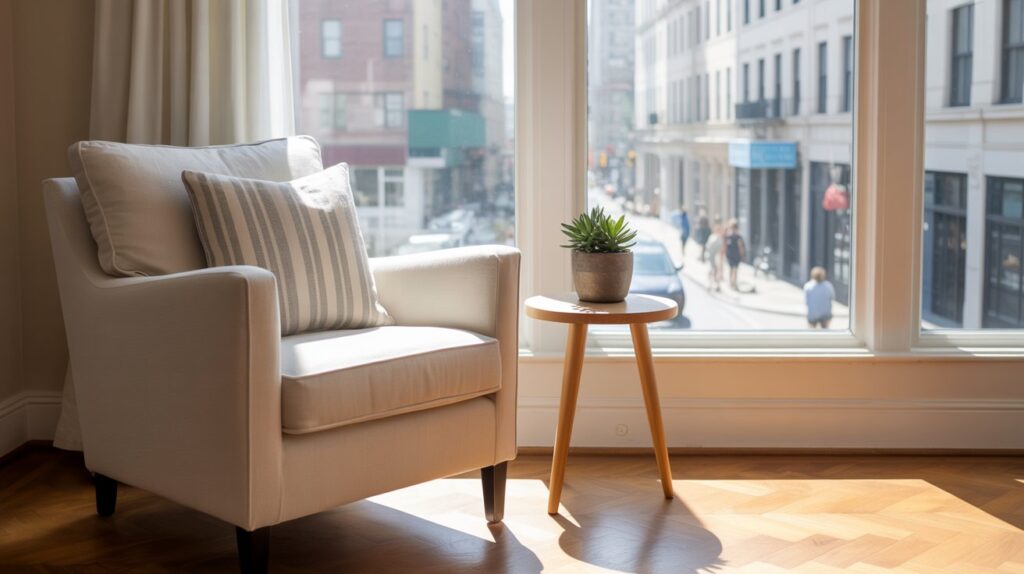
Essential Upgrades for Immediate Transformation
Start with pieces that earn their keep. A lift-top coffee table becomes a dining surface or workstation, while wall-mounted fold-down desks create instant office nooks. Vertical storage solutions like ladder shelves draw the eye upwards, making rooms feel airier while housing books and decorative items.
Consider ottomans with hidden compartments – perfect for stashing blankets or board games. Opt for nesting tables that tuck away when not in use, or install magnetic knife strips in kitchens to free up drawer space. As one Edinburgh interior designer notes: “The best solutions often hide in plain sight, quietly enhancing daily life.”
Where Practicality Meets Personality
These innovations shine by blending discreet functionality with aesthetic appeal. Velvet-upholstered sofa beds add luxurious texture while accommodating overnight guests, and geometric wall hooks turn entryways into curated displays. A recent London case study revealed how floating media units reduced visual clutter by 40% in cramped living rooms.
The true genius lies in details that multitask. Mirrored trays double as jewellery organisers and vanity displays, while tension rods under sinks create tiered cleaning supply storage. By prioritising adaptable furniture and intelligent storage, you craft spaces that feel both organised and authentically yours.
Maximising Vertical Space and Smart Storage Solutions
In compact homes, looking upward unlocks hidden potential. Walls become your greatest allies when floor space feels scarce, offering opportunities to store essentials while maintaining visual harmony. Thoughtful vertical solutions transform cluttered corners into streamlined displays of both practicality and personality.
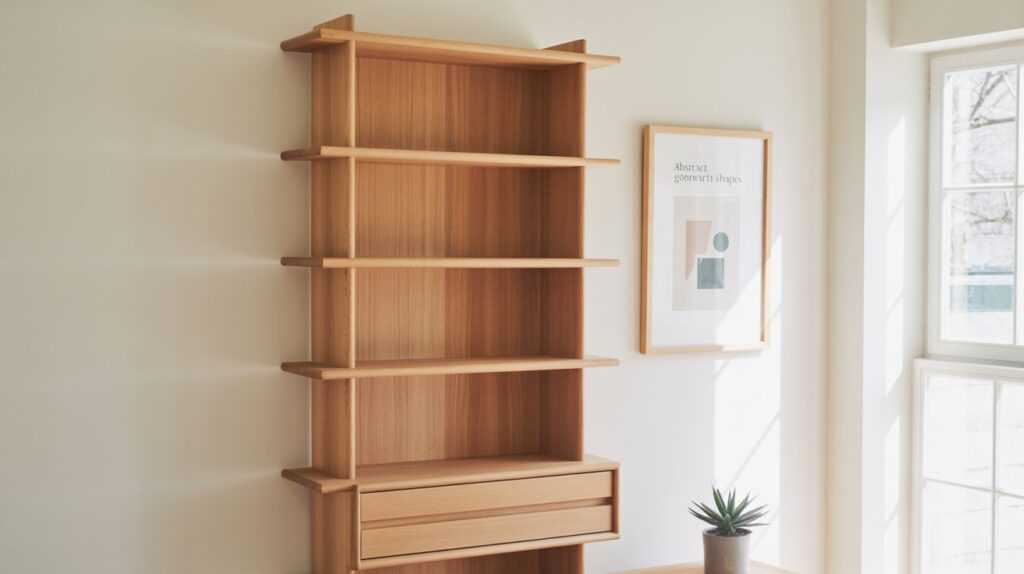
Utilising high-mounted shelves and wall cabinets
Floating shelves positioned near ceilings draw the eye upwards, creating an airier feel while housing books or decorative items. Slimline wall cabinets in kitchens keep countertops clear, with glass-fronted designs adding depth. A London-based organiser notes: “Clients gain 30% more usable area simply by rethinking their vertical surfaces.”
Consider these space-saving approaches:
- Built-in shelving around door frames for forgotten niches
- Magnetic spice racks mounted beside cookers
- Narrow ladder units that slot behind sofas
Innovative door organisers and over-the-door storage
Doors become functional features with the right additions. Try these discreet solutions:
- Hanging fabric pockets for cleaning supplies
- Over-door racks for shoes or folded linens
- Mounted wicker baskets in bathrooms
Recent DIY trends showcase painted pegboards transforming blank walls into adaptable storage systems. As one Manchester homeowner shared: “Our over-door jewellery organiser freed up an entire dresser – now it displays plants instead.” The key lies in solutions that feel intentional rather than makeshift, blending seamlessly with your existing decor.
Creating an Illusion of Space with Light Colours and Mirrors
Visual perception plays a surprising role in how we experience compact interiors. Recent studies reveal that strategic use of colour and reflection can trick the eye into perceiving up to 20% more area – a game-changer for constrained layouts. This approach balances science and style, offering subtle yet impactful ways to reimagine your surroundings.

Choosing a cohesive, light colour palette
Light hues act as visual pacifiers, reducing the brain’s perception of boundaries. A 2023 Dulux colour study showed that rooms painted in soft ivories or pale greys felt 15% more spacious to participants. For maximum effect:
- Use varying tones within the same colour family to add depth
- Continue wall colours onto ceilings to eliminate visual ‘stops’
- Pair with semi-gloss finishes that bounce light around corners
As Edinburgh designer Moira Kemp observes: “A monochromatic scheme isn’t about being boring – it’s about creating a serene canvas that lets your space breathe.”
Strategic mirror placement to enhance room size
Mirrors serve as spatial magicians when positioned thoughtfully. Try these techniques:
- Angle large mirrors opposite windows to amplify natural light
- Create ‘invisible’ storage by mounting mirrored cabinet fronts
- Use multiple small mirrors in grid patterns to scatter reflections
A Bristol case study demonstrated how positioning a full-length mirror behind a sofa doubled the perceived depth of a 4m² living area. Remember – reflection works best when it captures something worth seeing, whether that’s greenery outside or an interesting light fixture.
These approaches prove that sometimes, the most effective solutions are the ones you don’t immediately notice. Why not test a pale throw pillow arrangement or reposition that hallway mirror? The results might just reshape your understanding of what’s possible.
Multi-purpose Furniture to Boost Functionality
The secret to harmonious compact living lies in pieces that quietly multitask. Contemporary furniture design now prioritises adaptable forms that morph to meet changing needs, transforming cramped quarters into versatile living environments. By choosing items that serve dual purposes, you create breathing room without compromising on comfort or style.
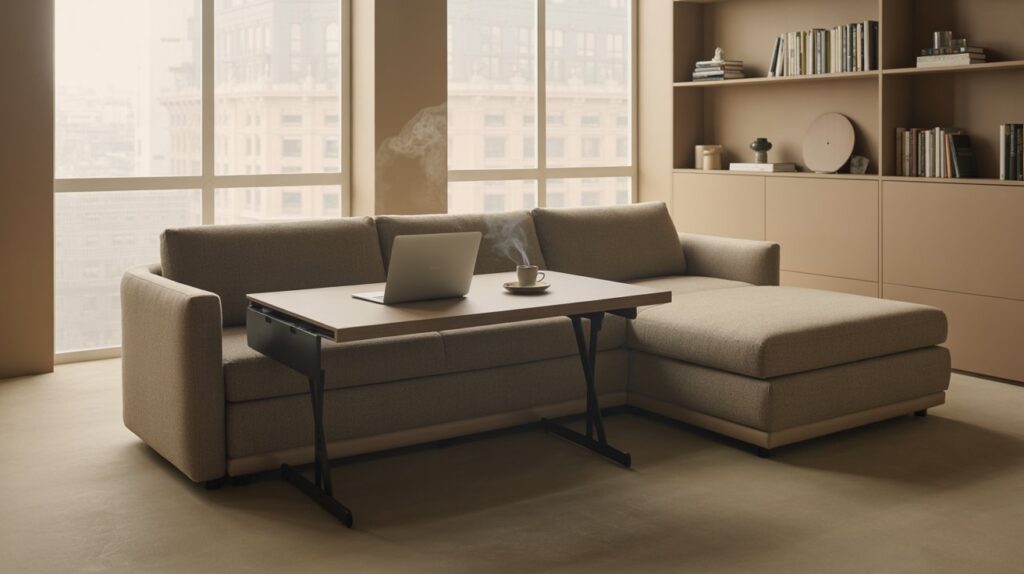
Want to skip the guesswork? I’ve gathered all my top-rated small space decor items into one list. Browse them here to make decorating your apartment even easier.
Intelligent Choices for Modern Living
Sofa beds epitomise this philosophy, offering plush seating by day and guest accommodation by night. Look for models with built-in storage compartments for bedding – a feature praised in recent Homes & Gardens reviews. Lift-top coffee tables work equally hard, their hydraulic mechanisms revealing hidden workspace perfect for laptops or craft projects.
Extendable desks demonstrate particular ingenuity in home offices. Wall-mounted versions fold flat when not in use, while freestanding designs expand for collaborative work sessions. As Manchester-based designer Clara Yates observes: “The best pieces feel like natural extensions of your routine, not obvious space-savers.”
Consider these strategic placements:
- Nesting tables beside armchairs for flexible surface options
- Ottomans with removable trays as impromptu side tables
- Banquette seating with under-cushion storage in dining nooks
Current trends favour clean lines and neutral upholstery, allowing versatile furniture to blend seamlessly into various room schemes. Whether you’re updating a studio flat or rethinking a terraced house layout, these solutions prove that practicality and elegance needn’t be mutually exclusive.
Innovative DIY Hacks for Personalised Decor
Breathing new life into compact spaces often starts with your own two hands. DIY projects offer a unique chance to craft solutions that reflect your personality while tackling practical needs. The beauty lies in transforming overlooked corners and ordinary objects into purposeful, eye-catching features.
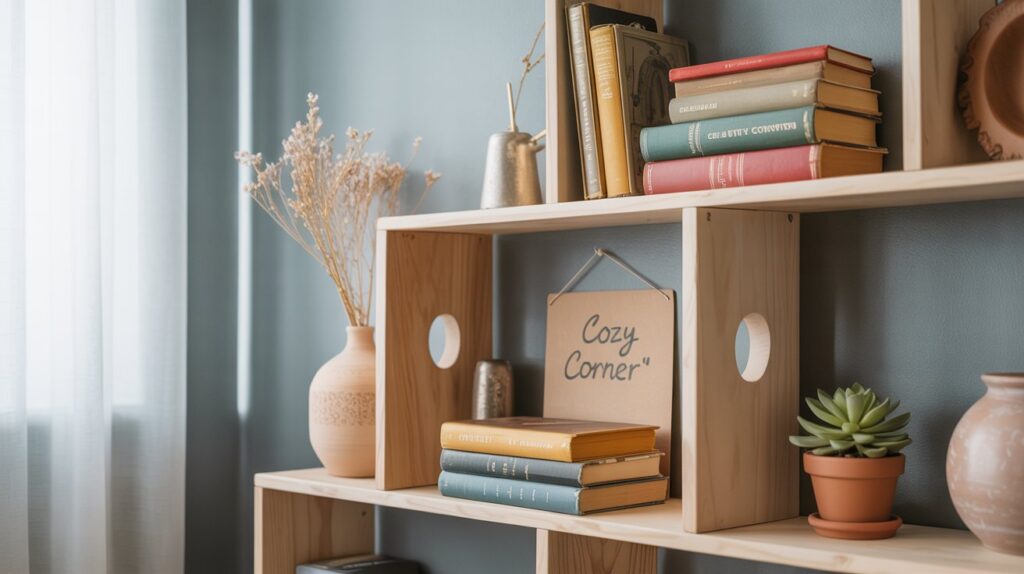
Custom Shelving and Built-In Storage Ideas
Forget standard shelf units – why not shape your own? A Bristol homeowner recently repurposed plumbing pipes into industrial-style shelves that hold books and display ceramics. Another approach uses painted wooden crates stacked asymmetrically to create visual interest while storing shoes or linens.
Built-in solutions work wonders in awkward niches. Try these:
- Floating ledges above radiators for plant displays
- Magnetic spice racks beside cooker hoods
- Shallow cabinets flanking chimney breasts
As noted on Flat55’s DIY blog: “The most effective storage often disappears into the architecture, becoming part of the room’s character.”
Adapting Everyday Items Into Decorative Focal Points
That vintage ladder gathering dust? Secured to the ceiling, it becomes a hanging rail for trailing plants. Old suitcases stack into quirky side tables with hidden storage. Even humble terracotta pots, when grouped and painted, transform into cohesive bathroom organisers.
Consider these transformations:
- Mason jars as bathroom vanity holders
- Scarf racks repurposed as jewellery organisers
- Baking trays turned magnetic memo boards
The genius lies in seeing potential where others see clutter. Start with items you already own – that chipped serving platter could become a statement wall clock. Your space should tell your story, not a catalogue’s. What hidden possibilities might you uncover this weekend?
Zone Creation for Distinct Living Areas
Mastering open-plan living begins with intentional design that carves purpose from every corner. Clever zoning transforms single rooms into multi-functional spaces, offering psychological separation where physical walls can’t. It’s about creating natural transitions between daily rituals without compromising spatial harmony.
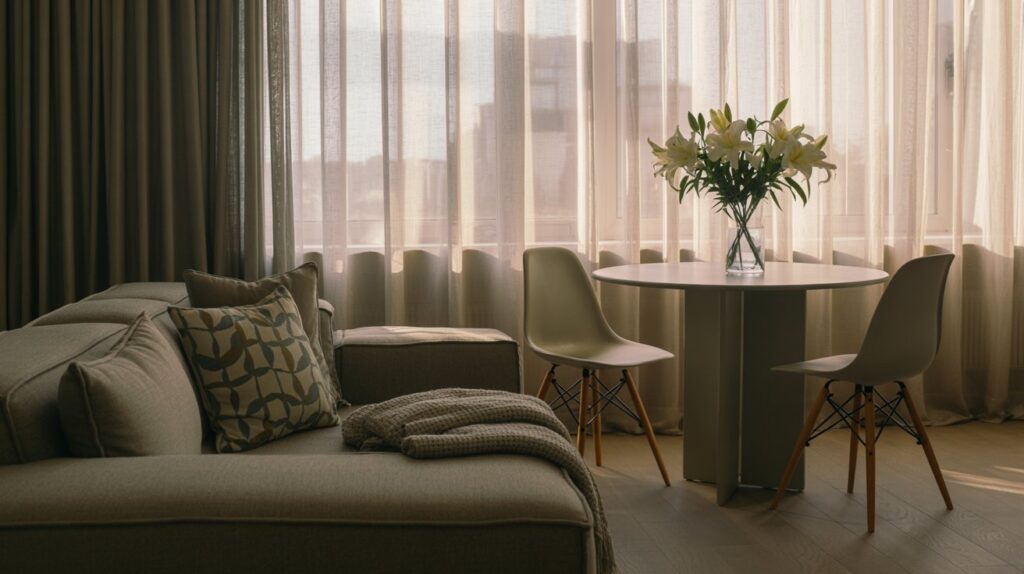
Defining living, sleeping, and working zones
Start by mapping your daily routines. A Glasgow studio owner achieved this by positioning her daybed perpendicular to the lounge area, using its high back as a visual divider. Simple strategies create clear boundaries:
- Layer rugs to anchor separate functions – think jute under the dining set, wool in the lounge
- Use open bookshelves as room dividers that permit light flow
- Paint accent walls behind workspaces to mentally ‘contain’ office activities
Lighting plays a pivotal role. A pendant over the dining table distinguishes it from adjacent living spaces, while task lamps signal work zones. As Brighton-based designer Ella Marlow notes: “The goal isn’t physical separation, but creating moments that tell your brain ‘this area serves a different purpose’.”
Maintain flow with cohesive elements. Repeat cushion fabrics across zones or continue flooring throughout. A London case study showed how aligning furniture legs with floorboard direction subtly guided movement between areas. Your bedroom nook might share wall colour with the lounge, yet feel distinct through textured bedding and lowered lighting.
Leveraging Natural Materials for an Airy Ambience
Natural materials bring a breath of fresh air to compact interiors, creating harmony between form and function. Their organic textures soften stark lines in minimalist rooms, offering visual warmth that synthetic alternatives often lack. As noted in Design Collective UK, spaces enriched with wood and rattan achieve a relaxed sophistication that feels both contemporary and timeless.
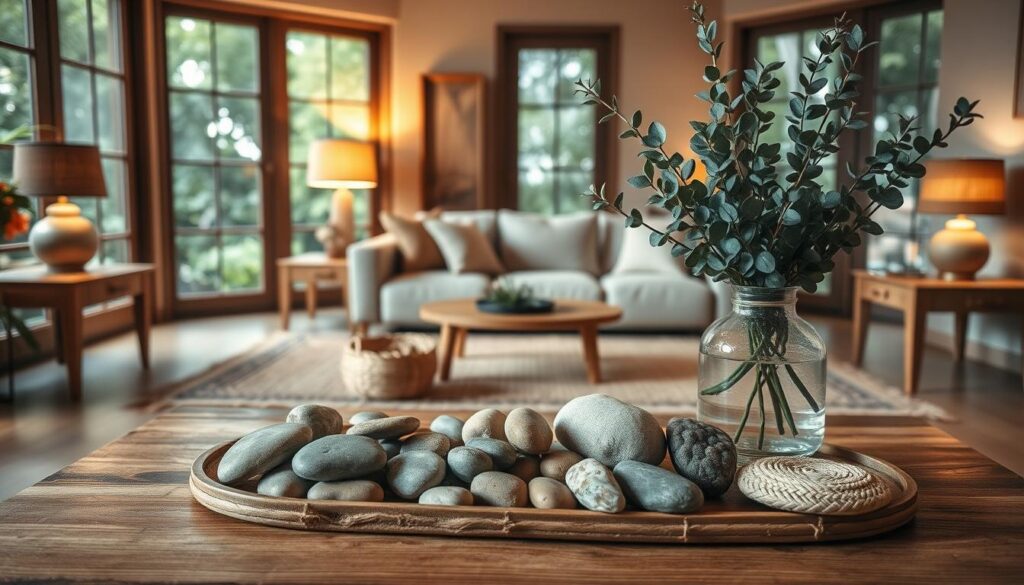
Using wood, rattan, and natural fibres for a warm look
Integrate these elements thoughtfully to enhance your home’s atmosphere. Light oak floating shelves add earthy tones without overwhelming small walls, while jute rugs define seating areas with understated texture. A recent London flat makeover showcased woven pendant lights that cast delicate shadow patterns, amplifying the sense of space through playful light diffusion.
Consider these approaches for balanced design:
- Layer linen cushions over a rattan armchair for tactile contrast
- Use reclaimed wood as floating bedside tables in apartment bedrooms
- Install bamboo blinds that filter light while maintaining privacy
Natural fibres excel in dual roles – a seagrass storage basket becomes a decorative focal point, and cork noticeboards add functional warmth to home offices. As Manchester-based stylist Erin Lowe observes: “Organic materials age gracefully, developing character that mass-produced items can’t replicate.”
These choices complement light-walled rooms beautifully, their neutral hues providing a cohesive backdrop. Why not experiment with a sisal rug beneath your dining set? Its subtle texture might just become the unifying element your apartment’s style needs.
Effective Kitchen and Bathroom Decor Hacks
The heart of a compact home beats in its functional spaces. Kitchens and bathrooms demand particular attention – their limited square footage must work harder than any other area. Thoughtful design choices here yield outsized rewards, transforming cramped quarters into models of efficiency.
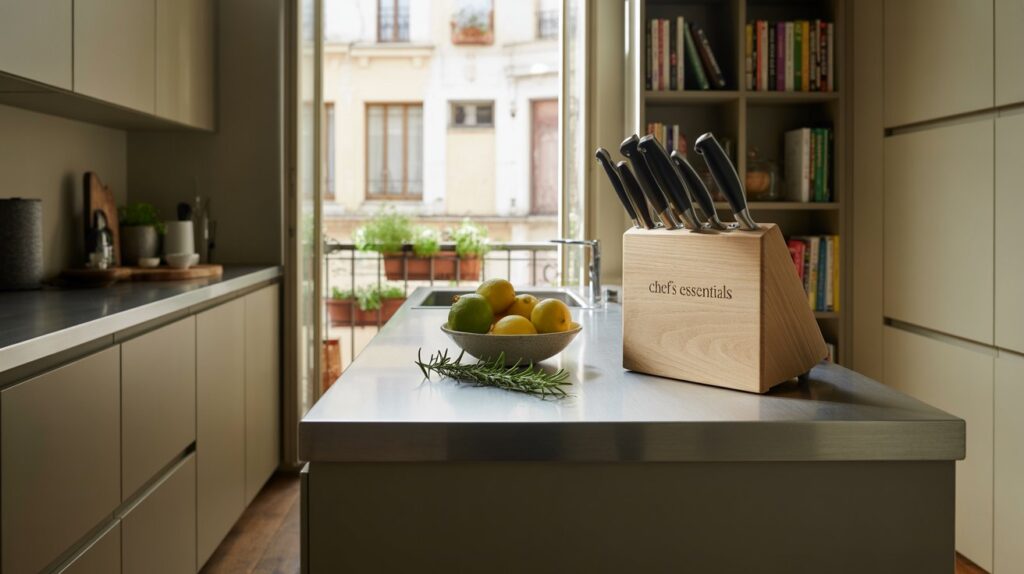
Incorporating Compact Appliances and Fixtures
Modern manufacturers now cater specifically to space-conscious homes. Slimline dishwashers at 45cm wide fit snugly beside cupboards, while combi washer-dryers eliminate the need for separate appliances. Wall-mounted taps and floating vanities create precious floor space in bathrooms, with recessed shelving making use of cavity walls.
Consider these space-savvy ideas:
- Induction hobs with integrated extraction systems
- Narrow pull-out larders for corner storage
- Shower screens that double as towel rails
As noted in House Beautiful’s latest roundup: “The best compact appliances disappear when not in use, letting your kitchen’s personality shine.”
Smart Organisers to Maintain a Clutter-Free Space
Clever storage solutions prevent these high-traffic zones from descending into chaos. Magnetic knife strips free up counter space, while tiered spice racks utilise cupboard height. In bathrooms, try under-sink pull-out drawers for toiletries or over-door racks for folded towels.
Try these approaches:
- Stackable containers for dry goods with chalkboard labels
- Wall-mounted toothbrush holders with integrated drainage
- Adjustable tension rods creating vertical storage zones
One London apartment owner shared: “Our pegboard kitchen wall organiser cut prep time by keeping tools visible yet tidy.” The goal? Solutions that feel intentional, turning necessity into stylish decor features.
Illumination Techniques: Lighting That Enhances Your Home
Light shapes more than what we see—it defines how we feel within four walls. In compact homes, thoughtful lighting creates depth while softening edges, transforming cramped quarters into inviting retreats. The magic lies in layering different sources to suit both function and mood.
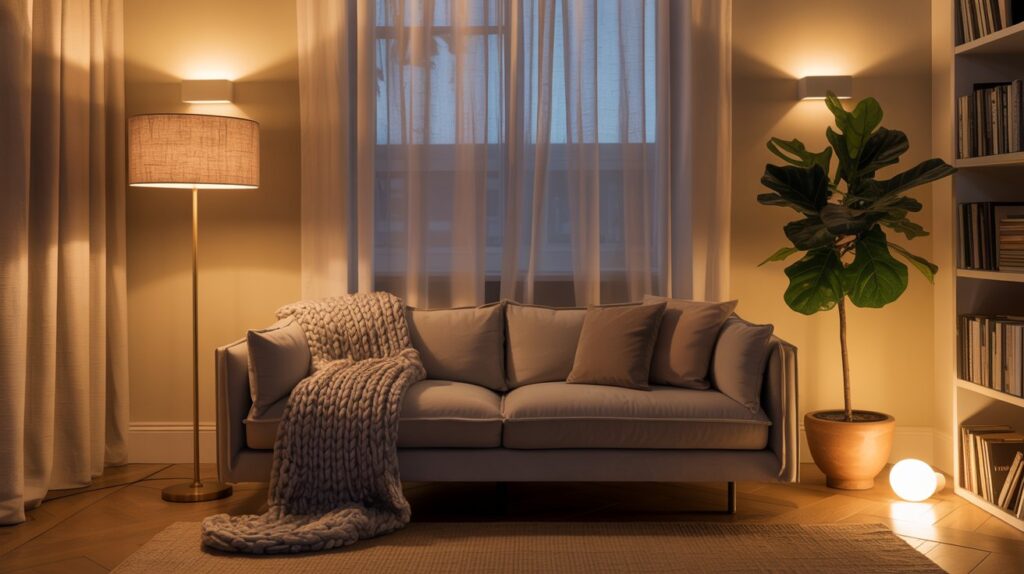
Mixing Ambient, Task and Accent Lighting for Depth
Start with ambient light as your foundation. Soft ceiling fixtures or uplighters wash walls with warmth, making low ceilings feel taller. Add task lighting where precision matters—think adjustable desk lamps or under-cabinet strips in kitchens.
Accent pieces add sparkle. Try these ideas:
- LED strip lights behind shelving to highlight collections
- Directional spotlights grazing textured wall surfaces
- Table lamps with dimmers for evening ambiance
As London lighting designer Tamsin Smith advises: “Three light sources per room maintain balance—one overhead, one task-oriented, and one that makes you smile.”
Creative Ideas With Wall Sconces and Pendant Lights
Wall sconces free up surface space while adding architectural interest. Flank a mirror with swing-arm models in bathrooms, or cluster geometric designs above a sofa. For dining areas, pendant lights hung at varying heights create intimate pools of illumination.
Consider these tips:
- Use drum-shaped pendants to diffuse light evenly
- Install sconces with USB ports for practical charging points
- Choose finishes that complement existing hardware
Brighton-based interior stylist Noah Carter notes: “The right fixture becomes jewellery for your room—functional decoration that elevates the whole scheme.” With strategic placement, your lighting becomes both tool and artwork.
Conclusion
Your journey towards a more intentional home begins with seeing potential in every corner. By blending multi-functional pieces like sofa beds and nesting coffee tables with vertical storage on walls, you create spaces that adapt to life’s rhythms. Remember – a well-placed desk near a window becomes both workspace and sunlight haven, while hooks in the entryway keep daily essentials within reach yet out of sight.
Small shifts yield profound results. Switching your dining table’s orientation or layering rugs under furniture can redefine a room’s flow. Those items you once considered obstacles – awkward alcoves, narrow walls – become opportunities for custom shelving or curated displays.
Approach your office nook and living areas with equal care. A coffee station on a floating ledge saves kitchen space, while mirrored accents amplify both light and the illusion of depth. As you experiment, let functionality guide your choices without dimming personal style.
Ultimately, elegant living in limited square metres comes down to thoughtful curation. Start with one change – perhaps repositioning that second-hand armchair or installing wall-mounted desks. Your home isn’t just where you live; it’s how you choose to thrive within its walls.
I’ve rounded up my go-to space-saving essentials in one place—see what I use and love on my collection here!

